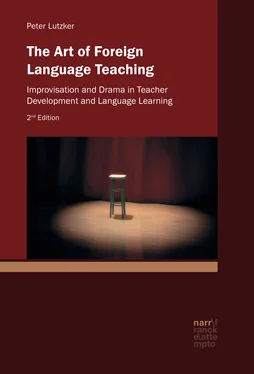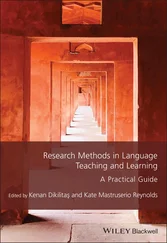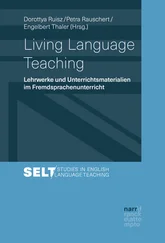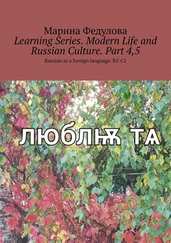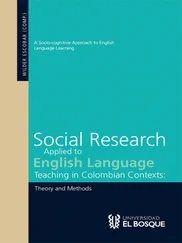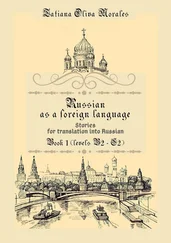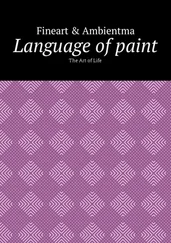Those elements which he stresses in all of his exercises – listening closely, learning to be completely non-judgemental, developing the powers of empathy and compassion – are the basis of his own manner of working with each of the teachers/learners. Again and again in his work with individuals, one sees how this pedagogical attitude offers the learners the chance to transcend their own personal borders and to realize their own, individual artistic possibilities. He writes,
I think a compassionate teacher can cultivate this discovery, in which the student’s apparent limit can reveal itself as a bridge, which unites him with the world, which spans the fearful gap between himself and the other, but it’s important that you, the teacher recognize the “limit” not as an obstacle, but as an opportunity, and invite the student to enjoy rather than fight, the quality that he has. For that boundary is a very rich, very fertile zone. For instance, if you have a student very timid about using her voice, it’s probably counterproductive to ask her to sing Figaro or Die Walküre: that’s exactly what she won’t do, because she’s afraid, and the nature of fear is contraction. But if you have the others close their eyes and ask her to make the sound of a sunset, you might unlock something in her. I often find this kind of synesthetic crossover very liberating. (…) By the way, this will work ONLY if you, the teacher, honestly have no preconception about the correct sound of a sunset: if there is one molecule of your being prepared to judge the response, then you’re lost from the start. You must remain very light, because you’re facilitating a bridge, and it could collapse: the artist – in this case the timid student– has to create a connection between what everyone knows – a sunset is red and what only she knows – a sunset sounds like this. (…) This is for me what transcending boundaries is about: a sense of union. “I know you through me, I know me through you”, because it’s the listening as much as the sound which creates the act.205 (emphases in original)
There certainly could be no more fitting audience for such processes than a room full of teachers.
4 An Empirical Study of Clowning Courses with Vivian Gladwell – Research Design
4.1 The Choice of the Clowning Courses
The choice to conduct an empirical research study on the clowning courses, instead of any of the other artistic workshops was made for a variety of reasons. Despite the many similarities between clowning and the other courses, the differences are significant.
As will become evident in the description of the clowning workshops and in the participants’ responses, it lies in the very nature of theatre clowning and improvisation that unique opportunities of addressing critical and complex pedagogical issues are continually presented. Those attributes of artistry in teaching that have consistently been viewed as decisive, including fluidity, creativity, sensitivity etc., are all contingent upon acting and re-acting in a given moment. In contrast to theatre, an artistic lesson is not an uninterrupted, rehearsed performance, but a highly dynamic process resulting from the continual interaction between pupils and teacher. In this sense, it is highly dependent on improvisatory skills which, in turn, are based on an entire set of requisite capabilities, most notably a high degree of openness, perceptual awareness, flexibility and presence. Such skills constitute the basis of theatre clowning and, in vital respects, can also be considered to be the basis of artistry in teaching.
Learning to develop such capabilities in the highly focused context of clowning improvisations can be a demanding process. The most common hindrance is generally that self-critical, judgemental ‘inner voice’ which Blake called one’s ‘ Spectre ’. Through continually passing judgements, this inner voice can effectively block any process dependent on imaginative and spontaneous action/s. This type of critical self-evaluation is often tied to fears of making mistakes and fears of failure. In encouraging teachers to develop a fundamentally different attitude towards their doubts, fears and insecurities, clowning addresses this level of behaviour directly. In doing so it also touches on those types of feelings in teachers, which are often the prime hindrance to their pupils’ developments. Particularly in foreign language learning, it is pupils’ fears of making mistakes and their feelings of being incompetent which often stand in the way of their acquiring that willingness to take risks vitally necessary in learning a foreign language. In a theatre clowning workshop in which teachers gradually learn to improvise spontaneously and creatively through freeing themselves from their own judgements, this decisive pedagogical process is experienced first hand by the teacher . Thus, more directly than in any of the other drama courses, a clowning workshop offers participants many chances to directly confront these types of anxieties in the context of artistic work, and also gives them an opportunity to experience such difficulties and themselves from a new perspective.
It is partially in light of the above considerations that I chose to focus on the clowning workshops. However, there were a number of other factors that also led to this choice. Both the structure and manner of working remain relatively constant in all of Gladwell’s workshops, in contrast to the other drama workshops which tend to vary more widely from year to year. This clearly lends itself better to general descriptions of their content and structure. The fact that he also described his own workshops in his Masters Degree was a further help.206 Moreover, as he has also worked extensively with other professionals including doctors, therapists, nurses and ecologists, there are chances of drawing parallels and distinctions to his work in other social professions. In this respect it has proved helpful that there has been an increasing body of articles published in various fields regarding his work.
Finally, since he also worked with Steiner School language teachers outside of the English Week, in the context of the English Fortnight at Emerson College for two summers, in the Baltic Seminar, in Helsinki, Finland for one summer and in the framework of intensive weekends in Witten-Annen, Germany, there were possibilities to get feedback responses from a greater number of teachers, including some whom I had never met (all those from the English Fortnight), and others whom I did not know from the English Week (I was a guest lecturer in January, 2005 at the Baltic Seminar). Thus, a potential corrective was offered to what otherwise could have conceivably been considered a problem in the research design – whether teachers’ responses to a clowning workshop in the English Week could have been consciously or unconsciously affected by their knowledge of my role as one of the organizers responsible for the courses.
In both Anglo-American as well as in German pedagogical literature there has been an acknowledged lack of empirical research devoted to assessing the effectiveness of both pre-service and in-service language teacher education programs despite compelling reasons for doing so.207 In the following study of the clowning and improvisation courses which Vivian Gladwell has regularly given for Steiner Schools language teachers since 1996, the attempt will be made to establish a well-grounded basis for assessing the meaning of this work. Although there is always verbal and sometimes written feedback given at the end of each of his courses, there have been no attempts made to collect and evaluate this data in a systematic way. Moreover, there is often little time or opportunity on the last day of a workshop to write more sustained comments. There has also been no research conducted until now designed to give participants the chance to reflect on these workshops, weeks, months, or years later. Hence, a critical and decisive question in evaluating any in-service training – What has a course meant in regard to a teacher’s further development? –has not been addressed in a systematic manner. This empirical study will attempt to redress that deficit.
Читать дальше
